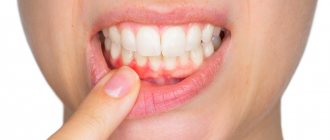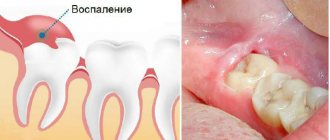What to do if your cheek is swollen after tooth extraction?
Often after a tooth extraction procedure, many people experience swelling that may persist for some time.
Its appearance is natural, since tooth extraction is essentially a surgical operation, after which the wound remaining in the oral cavity remains open. It recovers fairly quickly, but damaged gum tissue will remain swollen for some time. The size of the tumor may depend on several factors, such as the complexity of the removal procedure, the individual characteristics of the person, and the professionalism of the dentist.
Antibiotics for flux
As noted above, flux is a consequence of a bacterial infection, which is often treated by taking antibiotics. Many, at their own peril and risk, try to cope with inflammation by independently taking quite strong medications that can cause serious damage to the health of the entire body. Effective and at the same time safe treatment of flux with antibiotics can only be prescribed by a qualified specialist.
Antibiotics for flux are prescribed by a doctor individually. Self-use of strong medications is fraught with serious consequences for the entire body.
Antibiotics, like anti-inflammatory drugs, are used in dentistry for flux as part of complex maintenance therapy. The only way to stop the inflammatory process and remove the pus is surgery. Antibiotics are usually prescribed at the very beginning of treatment if the disease is in the earliest stages of its development, but identifying such inflammation at the initial stage can be quite difficult. As a rule, the dentist is able to detect the very first signs of periostitis by accident, for example, during a routine examination of the oral cavity. The specialist prescribes antibiotics for flux individually, depending on the characteristics of the patient’s body and the general clinical picture.
Signs of a tumor that is not dangerous to health
- swelling of the gums and cheeks does not increase and does not have a pronounced form;
- after removing a tooth that caused severe pain, or a wisdom tooth, discomfort and pain should gradually subside;
- even if during the removal procedure you had a slight fever, it should no longer be present, and in no case should it rise;
- there is no unpleasant odor from the hole, which may occur in case of complications.
The cheek tumor can reach its maximum size the day after tooth extraction. Then the swelling should subside.
Flux - treatment in children
If a child has flux, you should never give him medications on your own, and especially antibiotics. Only a dentist can prescribe a medicinal course of treatment. Antibiotics destroy both pathogenic and beneficial bacteria that help fight infection, so the unauthorized use of such serious drugs can lead to negative consequences for the child’s entire body.
Treatment of gumboil largely depends on the causes of its occurrence. So, this process is not much different from the treatment of periostitis in adult patients. As a rule, to begin with, the specialist makes a small incision in the area of the inflammation and ensures the outflow of pus using a special drainage system. The treatment then continues at home under the supervision of parents. Most often, a complex of medications is prescribed, but in some cases, a specialist may allow you to limit yourself to rinsing with special decoctions and solutions.
How to remove swelling of the cheeks and gums
If the tumor does not cause particular concern, then it is a natural phenomenon after tooth extraction.
There are ways to relieve pain and reduce swelling, as long as it is not harmful to health.
- It is necessary to apply cooling compresses to the inflamed cheek several times during the day, this can be a bottle of cold water, ice in a cloth, a damp towel, which should be kept for twenty minutes, periodically cooling it in cold water. You will immediately feel relief and notice how the tumor decreases in size.
- People with high blood pressure are more susceptible to post-operative swelling. They are recommended to take sedatives and blood pressure-normalizing medications after tooth extraction.
- Conventional anti-edema products can relieve swelling well - gels, creams, ointments that can be applied to the outside of the cheek.
- To relieve pain, which is inevitable after complex removals, you can take a painkiller (except aspirin) or an anti-inflammatory drug and lie down to rest.
Indications for surgery
- Cyst due to periodontitis. As a rule, if it is small in size, it is treated with medications. Surgery is resorted to when the tumor has reached more than 1 cm in diameter.
- Poor filling of the canals, which can cause inflammation.
- If treatment is required on a tooth that has a crown.
Thus, root resection helps not only to save the diseased tooth, but also to prevent the spread of infection to healthy tissue.
Contraindicated actions for swelling:
- Under no circumstances should you heat the swollen area, or touch the wound with your hands and tongue;
- rinsing on the first day after tooth extraction is not recommended, as it can wash away the blood clot that protects the socket from infections. In the future, you can rinse your mouth with antiseptic solutions - miramistin, furatsilin, or decoctions of chamomile, sage;
- the first two to three hours after the removal operation, you should refrain from smoking, drinking and eating;
- Until the wound is completely healed, you should not consume solid food, hot and carbonated drinks, or alcohol.
If you follow these simple rules, the swelling will go away quickly enough and there will be no need to visit the dentist.
How to treat flux?
If your tooth hurts and gumboil appears on your cheek, you shouldn’t panic and look for something to rinse your mouth with. “Grandmother’s” treatment methods really help get rid of acute pain and relieve some swelling, but they have not yet helped anyone cope with purulent compaction, which is the main danger. How and with what to treat flux? How to remove gumboil in case of gum inflammation? Only a qualified dentist can give detailed answers to these and other questions.
Self-medication with folk remedies will only help dull the pain and relieve swelling a little. Only a qualified dentist can completely remove pus and eliminate the cause of inflammation.
How is flux treated in dentistry? Currently, there are two main methods of treating gumboil on the cheek:
- Opening the pus sac, in which the doctor removes the accumulated pus through a small incision. The procedure is performed under anesthesia. After removing the pus, the specialist installs a drainage at the site of the incision - a special rubber strip that ensures the outflow of pus and prevents the wound from healing ahead of time.
- Cleaning an abscess through a root canal is necessary if the inflammation is a consequence of caries or a crack in the tooth.
Often in advanced stages of the disease there is a need for tooth extraction. Typically, this procedure is carried out when there is deep destruction of the causative tooth or if there is a large infected area between the tooth and the gum. Removal is also used if there is a sufficiently large crack in the tooth that cannot be treated.
Typically, the doctor begins by making an incision into the periosteum or lining of the mouth. The causative tooth is usually removed gradually, that is, in parts. For this, a special dental saw or laser is used. Modern equipment has made it possible to make the procedure for tooth extraction quick and completely painless, so there is no need to be afraid of treatment. After the operation, the sharp edges of the incision are smoothed, which is then washed with peroxide or other antiseptic agents and fixed with sutures.
When to see a doctor
If you have followed all the rules, carried out all the procedures aimed at reducing swelling, and your condition continues to worsen, then this is a sure sign that you need to urgently consult a dentist. Immediate medical attention is required if:
- the next day the swelling increased, and the pain did not decrease;
- the temperature has risen, general health has worsened;
- opening the mouth is accompanied by painful sensations, and the smell of rotting from the hole is felt.
All these symptoms should prompt an immediate visit to the dentist to avoid serious consequences.
Swelling after resection of the root apex
What is resection? Postoperative period
Recommendations in the postoperative period
Any competent dentist will try to keep the tooth alive, even if a cyst or other inflammation has formed at the top of the root. Fortunately, today doctors have more and more opportunities for this; for example, they can remove a cyst without depulping the tooth. This operation is called resection of the apex of the tooth root. However, swelling often appears after it. Is this normal and what should I do?
Stick to a diet
The diet while wearing drainage is special. Food should be:
- mushy or liquid consistency;
- room temperature;
- do not irritate the mucous membrane.
Possible gum damage also depends on how you eat. It is better to chew in small portions on the opposite side.
Additional Information! You can eat anything that does not injure the wound. Avoid hard, salty, smoked, spicy, sticky foods - they slow down healing and become clogged into the cavity.
Rest after surgery
The first few hours after drainage installation are the most critical. During the procedure, the dental surgeon needs to administer anesthesia, cut the gum, pump out the pus, and perform an antiseptic treatment of the cavity. The patient is weakened by the infectious process and the operation itself. Therefore, upon returning home, it is recommended:
- sleep for a couple of hours;
- take painkillers and anti-inflammatory drugs after the anesthesia wears off - Nimesil, Nise, Nurofen, Ketanol;
- do not drink or eat for several hours.
Why install drainage?
In dentistry, drainage is used in the following cases:
- for tissue healing after removal of a problematic tooth;
- with alveolitis;
- after opening the flux;
- when an abscess or cyst forms;
- for administering medications directly into the wound.
The patient should not worry if his gums were cut and a drainage system was installed. Drainage is used to remove purulent exudate and ichor. If drainage is not installed, the opened source of infection will heal quite quickly after cleansing, but if the inflammatory process is not stopped, the formation of purulent masses will begin again. In this case, a new operation will inevitably be required.
Avoid gum damage
If you handle cutlery, hygiene products carelessly, or get bumped or dropped, the drainage will not be level, will move, or will fall out prematurely. This is extremely undesirable, since the outflow of pus stops, and the edges of the wound begin to shrink.
The drainage is usually removed after 3 to 5 days by the doctor or patient. If it fell out earlier, you need to go to the clinic. The dentist will assess the patient's condition. In the absence of severe swelling or exudate, the doctor will recommend only drug treatment. When the inflammatory process does not subside, re-installation of the elastic tube will be required.
Improvement after installation of drainage should occur within the first day. If the tumor increases, the pain intensifies, and the temperature does not subside, you must tell your dentist.
Recommendations after gum incision
If you are planning an implantation or removal of a cyst, be prepared for the fact that the dentist will have to cut into the gum. When an unerupted or incompletely erupted wisdom tooth is removed from the gums, an incision is also inevitable.
After surgery, complications such as swelling, bleeding, and aching pain are possible. The reasons include decreased immunity, infection in the mouth, or improper care during the postoperative period. Therefore, the best thing you can do is to remember and follow all the doctor’s recommendations.
How to distinguish normality from pathology
On the one hand, tissue swelling is a normal consequence of the body, on the other hand, this symptom can become a manifestation of an inflammatory process that requires surgical therapy.
If the swelling does not have positive dynamics, that is, does not decrease 3-4 days after installation of the implants, if symptoms such as redness of the gums, monotonous or pain when pressing, increased body temperature, pus that is released from the area around the implant are added - all this speaks of a serious inflammatory process, i.e. peri-implant. And, most likely, implant rejection. If such phenomena occur, you should immediately consult a doctor.
You should also be wary of a situation where the swelling has already subsided, but reappears after some time. This situation again requires immediate consultation with a specialist.
Each patient of the Smile-at-Once clinic is assigned an individual manager, whom you can contact for advice in case of doubt. You will be connected with a doctor by telephone or an appointment will be made for an in-person appointment.
How is the drainage tube installed and what does it look like (photo)?
The drainage in the gum (look at the photo) looks like a small tube. Today, experts prefer drainage made of latex or rubber. Both materials are waterproof, due to which the device is retained in the infected tissue for a long time, is well tolerated by the patient and does not allow the wound to heal.
Before installing a drainage system, the dentist must first determine the location of the lesion and send the patient for an x-ray. During the examination, the depth and size of the abscess will be determined.
The doctor's next steps depend on the results of the x-ray. If the image confirms the destruction of the tooth root, the dentist must remove it, and then install a drainage tube into the open hole without an additional incision in the gum (see also: how to remove a tooth if its root remains in the gum?). In all other cases, the drainage procedure includes the following steps:
- administering local anesthesia;
- direct dissection of the gum tissue with a scalpel and its treatment with an antiseptic;
- fixation of the drainage system.
In case of flux, the doctor will make a releasing incision, that is, opening the abscess, after which he will install a system for the outflow of pus.
Maintain good oral hygiene
Brushing your teeth after any type of surgery is scary. Therefore, patients completely refuse hygiene or do not clean the operated area.
However, this situation is dangerous. Food debris and plaque accumulate in the oral cavity, are processed by bacteria and microbes, releasing toxins, and provoke inflammation.
It is necessary to maintain the highest quality oral hygiene. First, clean the interdental spaces with floss, then the crowns with a brush and paste, and complete the procedure by rinsing with an antiseptic.
Note! The teeth near the drainage are brushed very carefully so as not to displace the tube or injure the gums. You can use a soft bristle brush in this area.
Contraindications and complications of the procedure
Dentists exclude the procedure only in the most extreme cases. Contraindications include:
- disorders of the lymphatic system and blood clotting;
- predisposition to an allergic reaction to anesthetics.
Failure to comply with medical recommendations, the presence of infection or reduced immunity leads to complications. If a patient has a swollen cheek, pain, fever, or bleeding after his gum has been cut and a drainage system has been installed, he should immediately contact his dentist.
When an immediate visit to the doctor is not possible, the patient can use antiseptics that will help temporarily relieve pain and relieve swelling. You can rinse your mouth more often with a warm aqueous solution of soda, salt and iodine, Chlorhexidine, Miramistin, Chlorophyllipt, or lubricate the affected area with anti-inflammatory gels, for example Solcoseryl (we recommend reading: how to rinse the mouth after a tooth has been removed?). It must be remembered that rinsing in the presence of a drainage system in the mouth should not be too intense.
Avoid physical activity
The patient is prohibited from doing anything that provokes bleeding:
- engage in any sport;
- lift weights;
- do difficult homework;
- to take a bath;
- go to the sauna and solarium;
- travel for a long time in vehicles or fly on airplanes.
Read also: Flux swollen cheek
Important! If you do not follow these recommendations, the wound will bleed, heal for a long time, and pus may spread into nearby tissues.
Take prescribed medications
Postoperative treatment of purulent gum diseases is supplemented with drug therapy. Usually prescribed:
- antibiotics to relieve infection – most often “Lincomycin”, or analogue drugs “Tsifran”, “Amoxiclav”;
- anti-inflammatory drugs to relieve pain, heat, swelling - “Nimesil”, “Nurofen”, “Nise”, “Ibuprofen”;
- wound healing ointments to speed up healing - “Levomekol”, “Levomethyl”, “Metrogil Denta”.
Additional Information! Medications make recovery easier after drainage is installed. If you do not accept them, the process will be delayed. There is also a high chance of relapse of the disease.









